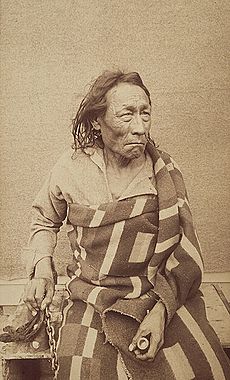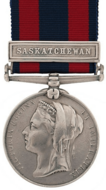North-West Rebellion facts for kids
Quick facts for kids North-West RebellionRébellion du Nord-Ouest (French) |
|||||||
|---|---|---|---|---|---|---|---|
| Part of the American Indian Wars | |||||||
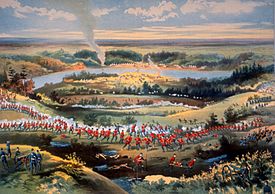 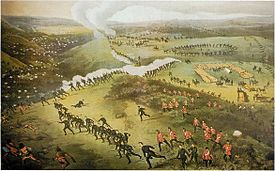 Top: Battle of Batoche Bottom: Battle of Cut Knife |
|||||||
|
|||||||
| Belligerents | |||||||
| Commanders and leaders | |||||||
|
|||||||
| Strength | |||||||
|
|
||||||
| Casualties and losses | |||||||
|
|
||||||
The North-West Rebellion (French: Rébellion du Nord-Ouest), also known as the North-West Resistance, was a conflict in 1885. It involved the Métis people, led by Louis Riel, and some First Nations groups like the Cree and Assiniboine. They were fighting against the Canadian government in what is now Saskatchewan. Many Métis felt that Canada was not protecting their rights, their land, or their unique way of life.
Louis Riel was asked to lead this protest movement. It soon turned into a military action. This upset some groups, including Catholic leaders and many Indigenous tribes. About 91 people died in the fighting that spring. The resistance ended when the government forces became too strong.
Even though the Métis and their allies won some early battles, the government's large army and a lack of supplies led to their defeat. This happened during the four-day Battle of Batoche. Many Indigenous leaders were captured and some went to prison. Louis Riel was also captured, put on trial, and found guilty. He faced severe consequences, which caused a lot of debate across Canada. The conflict helped complete the Canadian Pacific Railway. It also led to lasting disagreements between French and English Canadians.
Contents
What it's Called
This conflict has many names. People call it the North-West Rebellion, the North-West Resistance, or the 1885 Resistance. Sometimes it's called the Second Riel Rebellion. The words "rebellion" and "resistance" can mean similar things. But some people prefer "resistance" because it shows that Indigenous groups were defending their land and way of life. They were resisting the Canadian government taking control.
Why it Happened
After an earlier conflict called the Red River Rebellion (1869–1870), many Métis moved from Manitoba. They settled near the South Saskatchewan River in new communities. In 1882, government surveyors started dividing this land into square plots. But the Métis were used to a different system, where their land was in long strips from the river. This difference caused confusion and fear. Many Métis worried they would lose their homes and farms. Their main food source, the buffalo herds, had also disappeared. This made their land even more important.
In 1884, the Métis asked Louis Riel to return from the United States. He had left Canada after the Red River Resistance. They wanted him to speak to the government for them. The government's answer was not clear. So, in March 1885, Riel and others formed the Provisional Government of Saskatchewan. They hoped this would make the federal government listen, like it had in 1869.
The role of First Nations people in the conflict is sometimes misunderstood. By the late 1870s, many Indigenous people on the prairies were unhappy. The buffalo were almost gone, causing huge economic problems. Also, the government often broke the promises it made in treaties. This made many people angry. Big Bear, a Cree chief, tried to renegotiate the treaties. His efforts happened at the same time the Métis were feeling frustrated.
When some Cree groups started fighting in 1885, it was often separate from Riel's revolt. Small groups of Cree men, like those at the Frog Lake Massacre and the Looting of Battleford, acted against their chiefs' wishes. They were desperate and starving. But the government publicly claimed the Cree and Métis were working together.
Things were different for Riel and the Métis compared to the Red River Resistance. The Canadian Pacific Railway (CPR) was mostly built across the prairies. This made it easier for the government to send soldiers quickly. Also, the North-West Mounted Police (NWMP) had been formed, creating a local armed force. Riel did not have much support from English settlers or most other Indigenous tribes. Riel also claimed God had sent him back as a prophet. This made Catholic leaders worry and try to reduce his support.
Who Lived There
In 1885, the District of Saskatchewan had about 10,595 people. The central part, where the conflict happened, included the Southbranch settlements. About 1,300 Métis lived there. This area became the center of Louis Riel's Provisional Government. To the west was the Battleford area, where the Cree uprising took place.
The largest town was Prince Albert with about 800 people. Battleford had about 500 people, including French, Métis, and English speakers. Most of the 5,400 Métis in Saskatchewan tried to stay out of the conflict. About 350 armed Métis supported Riel. A smaller number were against him. Riel's supporters were often older Métis with strong ties to First Nations. They preferred speaking Indigenous languages. Those against Riel were younger and wanted to fit more into Canadian society.
The Conflict Begins
Louis Riel was asked to lead the movement. But he made it a military action with strong religious ideas. This caused many groups to distance themselves from him. At Batoche in May 1885, Riel had a few hundred Métis and some First Nations fighters. They faced 900 government soldiers.
First Clashes

On March 26, 1885, about 150 to 200 Métis and First Nations warriors, led by Gabriel Dumont, won a battle. They defeated 90 Canadian police and volunteers at Battle of Duck Lake, near Batoche. The government had already sent Major General Frederick Middleton to the West. He eventually brought 3,000 soldiers and added 2,000 volunteers and 500 police to his force.
On March 30, 1885, a group of Cree people, who were very short on food, approached Battleford. The people living there fled to Fort Battleford, a nearby police post. The Cree then took food and supplies from the empty stores and houses.
On April 2, 1885, at Frog Lake, a Cree group led by Wandering Spirit attacked the small town. They were angry about unfair treaties and the lack of food from the government. They gathered the white settlers in the church. After an argument, they killed the town's Indian agent and eight other settlers. Three people were taken captive. This event made the Canadian government realize the serious unrest in the West. Wandering Spirit was later put on trial and faced serious consequences.
On April 15, 1885, 200 Cree warriors attacked Fort Pitt. They ambushed a police group, killing one officer and capturing another. The fort's commander, Francis Dickens, surrendered. Big Bear released the police officers but kept the townspeople as hostages. Six days later, Dickens and his men reached safety at Battleford.
Government Prepares

The government knew an uprising might happen. So, before the Duck Lake battle, they sent Major General Frederick Middleton to Winnipeg. After Duck Lake, Canada quickly called up its part-time soldiers, called the Canadian Militia. They also called up their small regular army. By March 30, two trains with soldiers were ready to leave Toronto. Other units from Quebec City and Montreal also quickly got ready. Large crowds cheered as these young, inexperienced soldiers left for the West.
The first soldiers heading west faced many challenges. The Canadian Pacific Railway line had many gaps in northern Ontario. Soldiers had to march through snow or ride in open sleighs. Where there were short tracks, they rode on flatcars, which offered no shelter from the cold. Many soldiers suffered from the harsh winter weather. But thousands more troops followed in the weeks after.
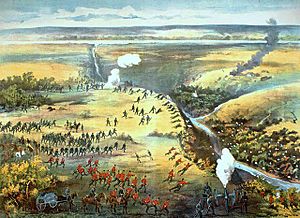
Other forces, like the Alberta Field Force, were also formed in the West.
Métis Victories in April and May
On April 24, 1885, at Battle of Fish Creek, 200 Métis won a notable victory. They fought against 900 government soldiers. This win, though not enough to change the war's outcome, stopped Major General Frederick Middleton's advance. He was heading towards Batoche, where the Métis would make their final stand.
On May 2, 1885, the Cree war chief Fine-Day successfully held off Lieutenant Colonel William Dillon Otter at the Battle of Cut Knife, near Battleford. Even with a powerful gatling gun, the Canadian soldiers had to retreat. Fine-Day was connected to Chief Poundmaker. Big Bear did not join this battle.
End of the Conflict
On May 9, 1885, Middleton attacked Battle of Batoche. The Métis were greatly outnumbered and ran out of ammunition after three days of fighting. They had to fire sharp objects and small rocks from their guns. Middleton's soldiers then advanced and defeated them. Louis Riel surrendered on May 15. Gabriel Dumont and others escaped to the Montana Territory in the United States. The Métis' defeat and Riel's capture ended their Provisional Government.
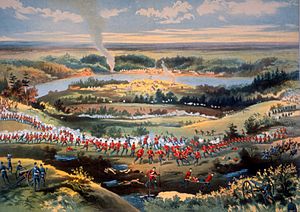
But the fighting with the Cree continued. By May 28, 1885, Major General Thomas Bland Strange and his forces caught up to Big Bear's Cree group. The Cree fighters won the battle at Battle of Frenchman's Butte at the end of May.
The last armed fight in the conflict was the Battle of Loon Lake. On June 3, 1885, a small group of police led by Major Sam Steele caught up to Big Bear's force. Big Bear's fighters had almost no ammunition left. They fled after a short exchange of fire and released their hostages.
Most of Big Bear's fighters surrendered in the next few weeks. On July 2, Big Bear surrendered to the police. The government sent food and supplies to help the Cree and Assiniboine who were facing severe food shortages. Poundmaker and Big Bear were sent to prison. Several others were also put on trial and faced serious consequences for actions outside of the military conflict.
What Happened After

Louis Riel was put on trial shortly after the resistance. He was found guilty of treason and faced severe consequences. His trial caused a big debate across Canada, especially between English and French Canadians.
The Canadian Pacific Railway (CPR) was very important in the government's response. It could quickly move soldiers to the conflict area. It took only nine days by train to move troops, compared to three months for the earlier Red River Rebellion. This success helped the railway, which was having financial problems. The government then gave enough money to finish the railway line. This helped Prime Minister John A. Macdonald achieve his dream of linking Canada across the continent.
After the fighting, new areas for local government were created. The 1885 Northwest Territories election was held. A special commission was sent to deal with Métis land claims.
This conflict was Canada's first independent military action. It cost about $5 million. It also caused the Conservative Party to lose much support in Quebec. The conflict showed that the national government could act strongly. It also helped establish English-speaking control of the Prairies. Soldiers and police who served in the conflict received the North West Canada Medal.
Long-Term Effects
The Métis in Saskatchewan asked for land grants, and the government provided them by 1887. The government also resurveyed the Métis river lots as they wanted. However, many Métis later sold their land to people who bought it to resell for profit. The French language and Catholic religion faced increasing challenges in Saskatchewan and Manitoba. The Métis were often forced to live on less desirable land.
Louis Riel's trial and the decision about his punishment caused a lot of anger and sadness, especially among French Canadians. This led to long-lasting disagreements between different groups in Canada.
Remembering the Conflict
In 2008, the government announced a special commemoration for the 125th anniversary of the 1885 Northwest Rebellion. This was a chance to share the story of the Métis and First Nations peoples' struggle. It showed how this event shaped Canada today.
Batoche, where the Métis Provisional Government was formed, is now a National Historic Site. You can find Gabriel Dumont's grave, the Batoche school, and the St. Antoine de Padoue Church there. You can also see Métis rifle pits from the battle.
Fort Carlton Provincial Historic Site has been rebuilt. Big Bear had used this site for treaty discussions. He later surrendered here. The Duck Lake Historical Museum and Interpretive Centre tell the story of the conflict. Murals in the town also show its history. The "First Shots Cairn" marks where the first shots of the Battle of Duck Lake were fired.

The Marr Residence in Saskatoon was used as a hospital for wounded soldiers. Fort Battleford is a national historic site. It was a military base and a refuge for settlers. Poundmaker was arrested there. Eight First Nations men faced serious consequences for actions at Frog Lake and Battleford. Fort Pitt Provincial Park is also a national historic site. It was the scene of a battle and where Treaty 6 was signed. The Frog Lake Massacre National Historic Site of Canada marks the location of the Cree uprising. Frenchman Butte is another national historic site, marking an 1885 battle.
At Cutknife, you can see the world's largest tomahawk. There is also the Poundmaker Historical Centre and a monument for Big Bear. A stone marker is on Cut Knife Hill, the site of the Poundmaker Battle. Steele Narrows Provincial Historic Park marks the site of the last fight of the conflict.
The Royal Canadian Mounted Police (RCMP) training center in Regina was started in 1874. Its chapel, built in 1885, was used to hold Indigenous prisoners. One of the old government buildings in Regina is still standing. It was the site of Louis Riel's trial. The play The Trial of Louis Riel is still performed there. Louis Riel was put on trial in May and faced consequences on November 16, 1885. His body was taken to Saint-Vital and then buried in Saint-Boniface Basilica in Manitoba, his birthplace. Saskatchewan Highway 11 is named the Louis Riel Trail. It passes near many places important to the conflict.

Soldiers from the Canadian Militia are remembered with memorials. These include the North-West Rebellion Monument in Queen's Park, Toronto, and The Volunteer Monument in Winnipeg, Manitoba. A statue for Wm. B. Osgoode and John Rogers, who died at Cutknife Hill, is in Ottawa.
In Fiction
- Red Trails (1935) by Stewart Sterling features a Mountie trying to keep peace during the rebellion.
- North West Mounted Police (1940) by Cecil B. DeMille is a film about a Texas Ranger helping the police stop the rebellion.
- The Magnificent Failure (1967) by Giles A. Lutz is a historical novel about the North-West Rebellion.
- Lord of the Plains (c. 1990) by Albert Silver focuses on Gabriel Dumont and his family.
- Battle Cry at Batoche (1998) by B. J. Bayle tells the story from a Métis point of view.
- Song of Batoche (2017) by Maia Caron is a historical novel. It shares the perspectives of Métis women, Gabriel Dumont, Louis Riel, and others.
See also
- Index of articles related to Indigenous Canadians
- List of conflicts in Canada
- Military history of Canada


